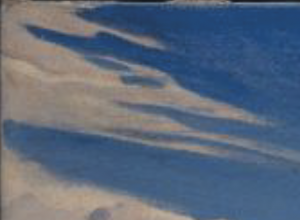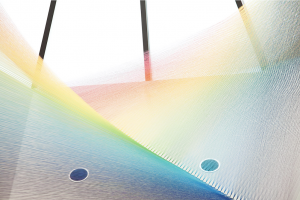Artists use lots of fun techniques to convey mood and feeling in their works. For example, emotions are often conveyed by how climate and weather are portrayed. In this Open Studio, a variety of weather conditions are represented in very creative ways. See if you can discover where weather plays an important role in the artworks below. When you find them, consider which paintings you wish you could jump into and enjoy, and which ones you would rather stay out of!
Exploring the Gallery

Sunshine: The sun brings us life, light, warmth, and energy. Lots of light in a work of art often makes it seem cheerful and optimistic. However, sometimes the light can seem too harsh and make the scene feel uninviting.
•How has the artist used the visual elements—light, shadow, line, color, brush stroke, etc.—to help us feel these emotions Maynard Dixon, 'Volcanic Cones (Boulder Nevada),' 1934, oil on canvas. Brigham Young University Museum of Art.
Clouds:


There are many different kinds of clouds, each with its own unique composition and location in the sky. Some clouds are made of ice and can be found high in the atmosphere, like the long, wispy cirrus clouds. Others are the big, puffy cumulus clouds we see in the summer. Made of water, they are much closer to the ground and often bring us rain.
•What kinds of clouds do you see in these paintings?
•Are they puffy or wispy? Peaceful or stormy? How do the clouds affect the mood of the painting?
Seasons: Weather is greatly influenced by the time of year and the changing of seasons. Here in Utah, we experience all four seasons to the fullest. However, the people who live just a few hundred miles south of here never even get to see snow!


•How would the mood of the painting change if the season were different?

After The Rain: As a special treat, look at Plexus no. 29, an installation made of string in the central lobby of the museum. In nature, rainbows appear when light shines through water droplets in the air, usually after it rains. Our rainbow, however, is made with 80 miles of string and took 10 days to create!
Art Activities:
Now that you have seen how artists convey moods through their depictions of weather in its many forms, you are going to create your own weather works!
1. Think about all of the types of weather you have seen today in the artwork and choose your very favorite.
2. Use a Sharpie marker and paper to draw a scene with the same weather conditions and the same mood as that of your favorite painting, either today or maybe on a previous museum visit.
3. After you have drawn your weather scene, use the small pieces of tissue paper and glue sticks to fill in your page with MOOD and FEELING, gluing the paper onto the sections of your work that you want to be the most expressive and colorful!
Did you know that the weather might be very different depending on where you live in the country — or even the world? With the help of a grown up, contact (email, Facebook, phone) a friend or relative who lives a long distance from you. Ask about his/her weather that day and compare the similarities and differences with your own weather. Then, each of you can create your own weather work of art, take pictures of them on your phone, push send, and share your weather work creations with each other! Share your weather-inspired artworks with us! Post on social media and tag #byumoa and #moafromhome